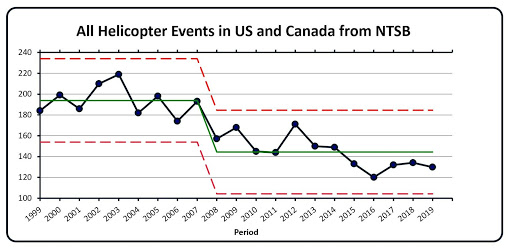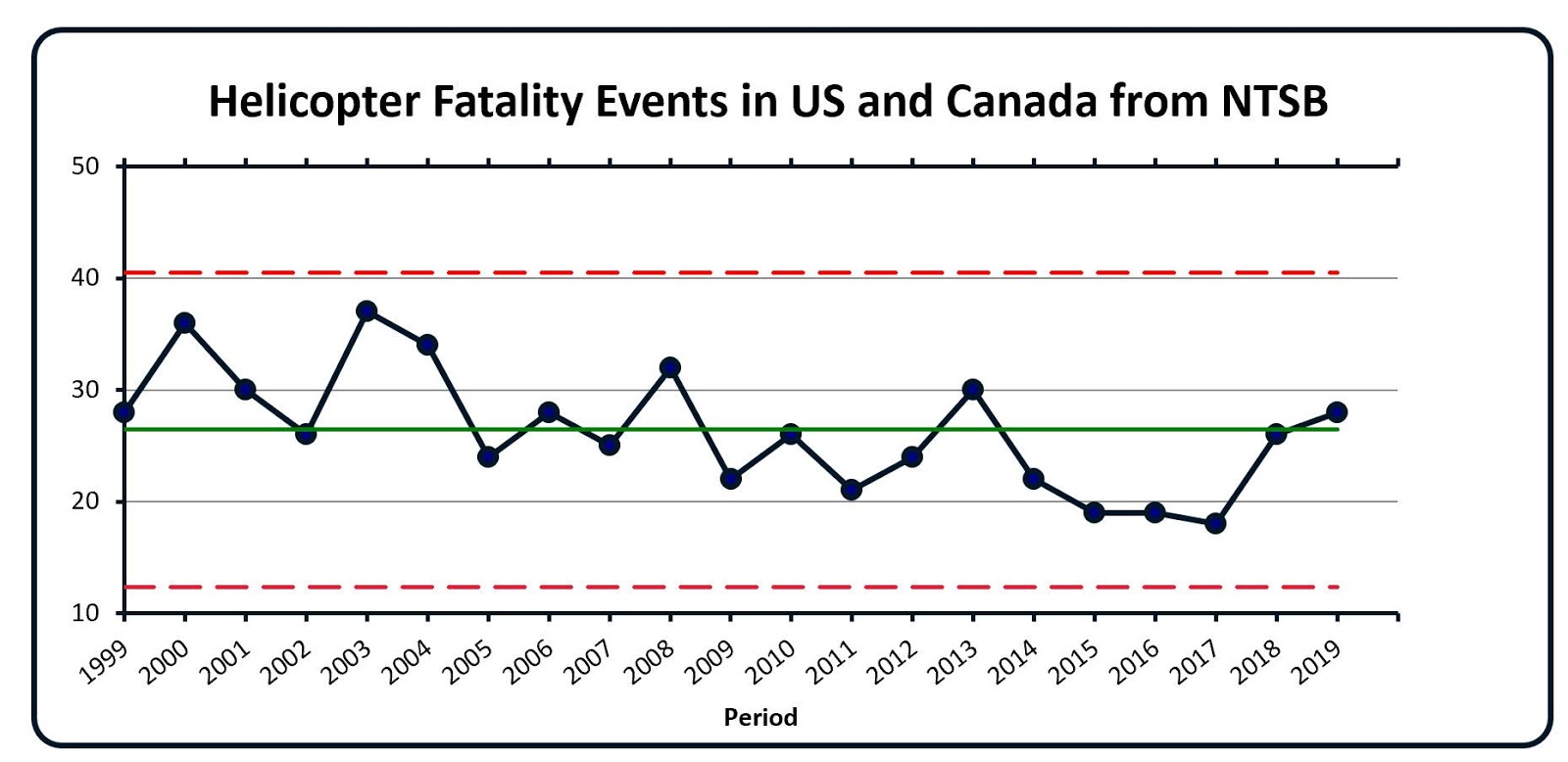Learning from the Kobe Bryant Tragedy, What does the data tell us?
Kobe Bryant, his daughter, and multiple friends were killed in a helicopter crash. Any fatal accident is a tragedy, but this one was acutely felt by fans of Bryant and by parents who could identify with the heartbreak of losing a child.
When a shocking event happens, because it was unexpected we look for some kind of exceptional cause. That focus is to be expected, but it can lead us to miss more mundane causes that are constantly present but only occasionally manifest in noticeable effects. This particular crash was not caused by a sudden calamity like a lightning strike or engine failure. To make sense of the tragedy and help prevent such events in the future, we need to look deeper at the causes contributing to it. That means quickly identifying and measuring the variation present in the process, then analyzing the variation to determine how it arises so we can control it.
One of the core elements of Six Sigma is endeavoring to differentiate special causes and common causes. Both causes are present and both contribute to variation in any process. Special causes are exceptional, atypical variation that occur sporadically in a process. Common causes are numerous, systemic, and chronic variation built-in to any process. We absolutely do need to identify special causes so we can prevent them, but we also absolutely need to identify common causes so we can control them and minimize their effects. By understanding the type of variation is affecting the process, we will be able to determine the correct method of improvement and in this case prevention.
When things go wrong, people often assume special causes are at work when common causes are the real contributors. For example, there is a very small chance of failure every time an aircraft flies. The more often you fly, the more that very small chance grows. That inherent risk is a common cause. Systems fail. You can never eliminate risks, but you can control them and control for their effects.
We spend millions of dollars and untold aggravations in airport security lines trying to prevent a bomb getting on an airplane (special cause). But do we spend enough time and money controlling for common causes? What can be done to reduce the common causes that relate to incidents with fatalities?
One of the methodological techniques Six Sigma offers is the practice of asking questions to five or more levels to get at underlying common causes. Here is one way to employ that practice on the helicopter crash that killed Bryant.
Q – Why did the helicopter crash? A – It wasn’t flying high enough over a hill.
Q – Why wasn’t the helicopter flying high enough? A – The pilot could not see the hill.
Q – Why couldn’t the pilot see the hill? A – There was dense fog and the helicopter was not equipped with radar needed to fly in dense fog.
Q – Why was the helicopter flying in dense fog? A – To avoid car traffic jams on clogged roads.
Q – Why are the roads so clogged? A – There isn’t sufficient infrastructure such as public transit to facilitate safe, easy travel.
We can see that our questioning could have forked off into another line of questioning: why were appropriate safety systems not installed on the helicopter? Either line of questioning leads us to common causes that contributed to the crash. Why did the crash happen? It was a combination of two common causes: the desire to avoid traffic jams and the lack of safety systems in the helicopter.
We can’t fault Kobe Bryant for wanting to avoid Los Angeles traffic congestion. Not all of us have the means to pay for helicopter transport, but would sure be easily tempted to fly over the clogged highways if we could. But would we have to even entertain such a choice if our roads and rail systems were adequate to handle the demand? The common cause of insufficient transportation infrastructure should not be ignored.
Whatever transportation conveyance we get on, we hope and expect that it is adequately safe. We should ask, if personal drones and cars have collision avoidance systems what kind of systems should be present in a helicopter? We should ask, what are the appropriate safety devices that should be installed on any craft, land, sea, or air, that transports people?
Again, common causes are always present. Problems fester until circumstances align to allow a major event to occur. Not taking action on common causes is itself a common cause that heightens the risk of defects. We need to define the common cause problems, measure and analyze these causes, and determine the best methods to improve and control them to minimize defects as much as possible.
Looking at the actual Helicopter Fatality Events as provided by NTSB the number of events with fatalities has not changed much since 1999. This would suggest the number of serious accidents with fatalities has changed very little since 1999. A systemic change is needed to reduce the number of incidents with fatalities.
How do we respond to these events? There are two aspects of our appropriate responses to common cause problems. On a personal level, we need to ask better questions. Does this helicopter have the appropriate safety equipment and measures? Is it really safe to fly in this weather? (Weather is a common cause.) Which is more important to me—speed or safety? And so on.
On an organizational level, we need to get the relevant data and do proper statistical analysis on that data. People in power need to be asking the right questions about processes and systems. Are we spending enough money to make transportation safe and efficient? Are regulations sufficient to minimize risk? And so on.
 Looking at the number of Helicopter Events as reported by the NTSB, these Events declined substantially since 1999. So the number of Events has reduced but not the number of Events with fatalities. What combination of common and special causes are contributing to these Events and their severity? What are the metrics that will leads us to understand the variation and how we can control them and control for their effects?
Looking at the number of Helicopter Events as reported by the NTSB, these Events declined substantially since 1999. So the number of Events has reduced but not the number of Events with fatalities. What combination of common and special causes are contributing to these Events and their severity? What are the metrics that will leads us to understand the variation and how we can control them and control for their effects?
Lean Six Sigma provides the methodology and the tools needed to differentiate special causes and common causes. Incorporating Six Sigma methodology in your organization empowers you to understand the causes that affect your processes and how you can act to improve them.
In the past week there have been a number of news articles examining the helicopter safety record. In some of these articles the interpretation of the historical data needs to be reviewed. Some of the conclusions reported are not consistent with the data. NTSB indicated they will be coming out with an initial report soon. I plan to review this report and follow up.
I am a firm believer that everything happens for a reason. Every tragedy like this is unacceptable but we need to learn and innovate from it. My condolences and prayers go to all of the people affected by this tragedy.
Author: Peter Peterka
Published 07/Feb/2020
SixSigma.us offers both Live Virtual classes as well as Online Self-Paced training. Most option includes access to the same great Master Black Belt instructors that teach our World Class in-person sessions. Sign-up today!
Virtual Classroom Training Programs Self-Paced Online Training Programs







